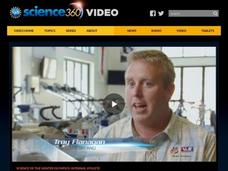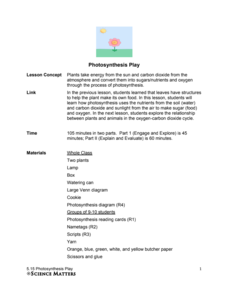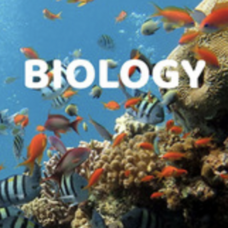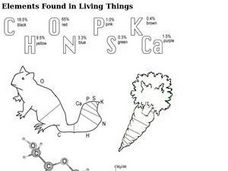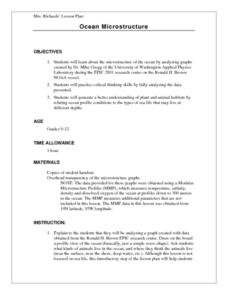Oxygen Teacher Resources
Hi, What do you want to do?
Find Oxygen lesson plans and worksheets
Showing 2,464 resources
The Brain Scoop
Crystal and Her Water Beetles
Water beetles live underwater their entire lives, getting air from a bubble they carry with them. The video, part of an Insect playlist by Brain Scoop, explains how they breathe and why they are fascinating for evolutionary studies. It...
American Chemical Society
Why is Carbon Monoxide So Deadly?
Don't fall victim to The Silent Killer! Expose your class (not literally) to carbon monoxide through an informative video from Reactions, a playlist from the American Chemical Society. Content includes carbon monoxide's structure, its...
American Chemical Society
Why Are Avocados So Awesome?
Is it just coincidence that avocados and awesome both begin with the letter A? Introduce young nutritionists to a super food with some super powers using a video from the Reactions playlist. Scientists from the American Chemical Society...
Royal Society of Chemistry
Compounds Ending in 'ate'
Tackle polyatomic ions with Sudoku-like games! Nomenclature novices practice identifying the names and constituents of carbonate compounds with a series of puzzles. Scholars can use the resource online or as a worksheet, thanks to the...
Socratica
What Are Functional Groups?
What's the function of functional groups? Explore the portions of biological molecules that make things happen with a video from Socratica's series on biology. The narrator illustrates each major functional group, then describes them in...
Socratica
What Are CHNOPS?
It's the stuff of life! Where would we be without CHNOPS? Biology scholars discover the elements essential to life with a video from an engaging biology playlist. Topics covered include lipids, proteins, and DNA, as well as the trace...
National Science Foundation
Internal Athlete—Science of the Winter Olympics
Cross-country skiers are some of the most disciplined athletes in the world. Young scholars learn about the biology of endurance in an interesting video lesson that highlights athletes of current and past Olympics.
Royal Society of Chemistry
Naming Esters
Do your chemistry scholars know their esters? Introduce the class to the nomenclature and structural formulas of common esters through thought-provoking games. Individuals or pairs of pupils match the name with the formula before using...
Royal Society of Chemistry
Electronegativity Values
Finally, an electronegativity resource your class will be strangely drawn to! Skilled scientists manipulate interactive puzzles to gain an understanding of common electronegativity values. The great thing? You can conduct the lesson...
Be Smart
The Cosmic Origins of Earth's Water
Was Earth born as a Blue Planet? Discover where water came from with a video from an intriguing science playlist. The resource covers the three most likely origins of water, how scientists differentiate between comet and asteroid water,...
Arbor Day Foundation
Trees are Terrific...Inside and Out!
Trees are the star of a three-step unit celebrating Arbor Day. Step one takes an in-depth look into the structure of a tree, the process of photosynthesis, and the benefits of the leafy giants. Step two challenges scholars to create a...
Learning Games Lab
Everything is Chemical
Chemistry is the foundation of good farming. Learners explore how chemical bonding applies to agriculture. The lesson highlights the difference between organic and inorganic compounds and how similar compounds bond in very different ways.
Learning Games Lab
Unavailability of Water in Saline Soils
Viewers of a short video learn about salt and water molecules and how their characteristics determine how they interact with each other. Then, they watch a simulation of how the interaction limits the uptake of water in plant roots and...
Howard Hughes Medical Institute
Vertebrate Circulatorium
When you get to the heart of the matter, you learn a lot about an organism by studying its circulatory system! A perfect resource for a zoology or anatomy class, the simulation gives users a peek inside a variety of vertebrates to...
Howard Hughes Medical Institute
Deep History of Life on Earth
Take it all the way back! Young scientists discover the changes that took place from the time Earth became solid to present day through an interesting interactive. The resource guides users through key events that have shaped our world...
Science Matters
Photosynthesis Play
Photosynthesis seems nothing short of magic: a little carbon dioxide and water, add energy, and poof, you get food! A thorough, collaborative lesson teaches youth the process of photosynthesis thanks to a skit they perform with a group...
Utah Education Network (UEN)
Utah Open Textbook: Biology
Curriculum resources can be expensive—but not this one. An online textbook offers informational text for a complete high school Biology course. Topics include energy flow, body system, genetics, and evolution.
Curated OER
Message in the Bottles
Students identify the three realms of the Arctic Ocean, and describe the relationships among these realms. They explain the relationships between gross primary productivity, net primary productivity, and respiration.
Curated OER
Science: Breathing in Space
Students determine the amount of air they use during rest and activity. They conduct experiments to calculate the number of breaths needed to empty a jug of water by exhaling through a tube into the container. Then, they figure how much...
Curated OER
Primary Producers
Students examine the role of carbon in the oceans and how phytoplankton determine the levels present. In groups, they practice measuring primary productivity using two methods. They use the internet to research the role of phytoplankton...
Curated OER
Key Scientists in Photosynthesis Research
For this photosynthesis worksheet, students use a textbook to research the different scientists involved in the discovery of the process of photosynthesis. This worksheet has 31 fill in the blank questions.
Curated OER
The Biological Carbon Cycle
Students learn about the biological carbon cycle. In this carbon cycle instructional activity, students access the web site and mouse over the diagrams to follow the carbon cycle. They read about what happens to humans and plants during...
Curated OER
Elements Found in Living Things
In this elements activity, students review the most common elements found in living things. Students color in two pictures with the percentages of the elements found in that living thing.
Curated OER
Ocean Microstructure
Students assess the ocean's microstructure by analyzing graphs created during tne Ronald H.Brown research cruise. they discuss at what depths various sea animals live and write paragraphs on data analysis from the graphs.
Other popular searches
- Carbon Dioxide Oxygen Cycle
- Dissolved Oxygen
- Oxygen and the Human Body
- Oxygen Cycle
- Oxygen and Carbon Dioxide
- Carbon Oxygen Cycle
- Oxygen Carbon Dioxide
- Oxygen Cycle Diagram
- Solubility Oxygen
- Mount Everest Without Oxygen
- Plants and Oxygen
- Transporting Oxygen, Glucose






